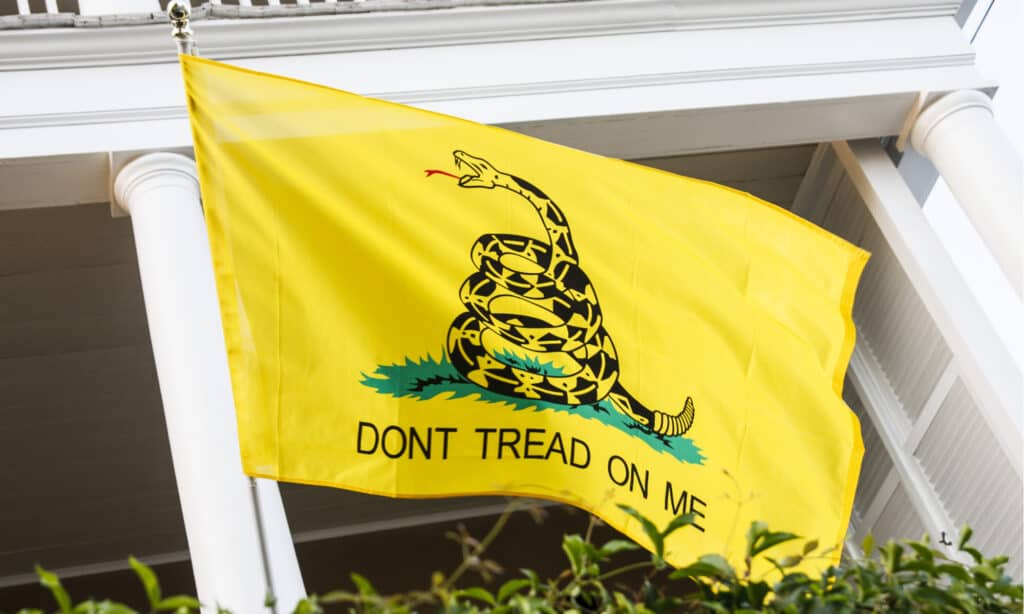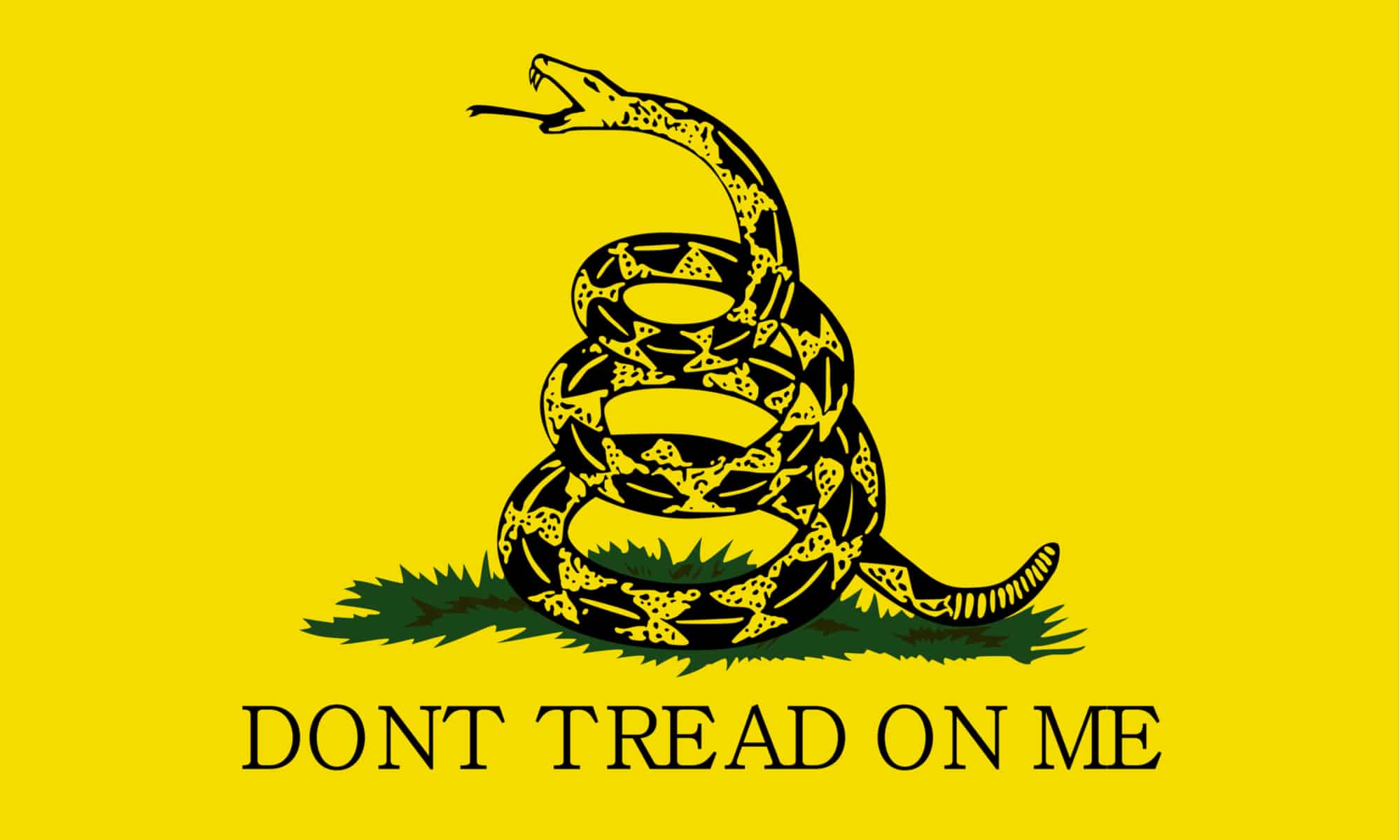You’ve probably seen the yellow “Don’t Tread on Me” flag floating around somewhere. Popular both historically and in certain contemporary circles, the famous flag has been used by many different groups throughout its 200-plus-year lifetime. But, just where did it come from, and why does it depict a rattlesnake?
Here, we’ll take a closer look at the Gadsden flag—otherwise known as the “Don’t Tread on Me” flag. We’ll start by going over its origins, and what it meant to the people who first used it. Then, we’ll explore the meaning behind the saying, and discover why the flag’s designer chose a rattlesnake to represent the early United States.
Read on to find out just how accurate the Gadsden flag really is, and whether or not rattlesnakes really “never back down.”
What Does “Don’t Tread On Me” Mean?
The “Don’t Tread On Me” meaning is an expression of freedom and liberty that first originated on the Gadsden Flag, depicting a coiled rattlesnake getting ready to attack, and used as a cry for independence for the American Colonies when fighting the British.
The snake was a well-established symbol for America during that time. Even Benjamin Franklin is notably quoted as saying “The rattlesnake never backed down when provoked.” This quote captured the temper and conduct of America during that historical time.
It became popular in the Revolutionary War and has resurfaced in modern eras as an expression of liberty, individualism, and independence. The Flag first appeared on a battleship in 1775. Christopher Gadsden created the Flag. Gadsden was a South Carolinian politician.
In the early 2000s-10s, “Don’t Tread on Me” and the broader symbolism of the Gadsden flag became even more politicized since its original creation in the 1700s. The flag since has been adopted by conservative and libertarian groups which include the Tea Party (2009). The flag and quote were also integrated into their platform for small government and the lowering of taxes.
Although, the flag has more recently been associated with right-leaning political groups and ideologues, but is itself not a modern conservative flag or design.
Join or Die vs The Gadsden Flag
There are two major flags that are the most well-known for the second half of 18th-century America. The Join or Die flag and the Gadsden Flag are weaved together in history symbolically, however, each has been used for different ideological groups over the span of hundreds of years.
The “Join or Die” flag depicts a timber rattlesnake cut into eight separate pieces. Each piece represents one of the existing colonies at the time of creation. The snake is depicted as dead, however, the image expresses that the Thirteen Colonies would also die if they did not unite to face the French during the Indian War.
Although both flags have connections to Benjamin Franklin, both have rattlesnakes, and both were created during a similar time in history, each flag represents a different meaning.
The Gadsden Flag represents the idea that government shouldn’t interfere with personal liberties whereas The Join or Die flag represents the need to unite against a common enemy.
Just What is the “Don’t Tread on Me” Rattlesnake?
The “Don’t Tread on Me” flag depicts a simple enough design; a yellow background, a rattlesnake, and the key phrase. In a way, it’s one of the United States’ first memes—let’s go over the flag in detail.
First, located at the bottom center of the flag are the words “Don’t Tread on Me.” Above those words is a coiled rattlesnake, usually depicted on a bed of grass. The rattlesnake’s bottom coil rests on the ground, while two more coils lift it into the air, like a Slinkee. Both the rattle and typical diamond markings are clearly visible, as are the rattlesnake’s forked tongue and exposed fangs.
It may not be an entirely accurate portrayal of a rattlesnake’s defensive coiled position, but it gets the point across: here is a rattlesnake curled up in warning, ready to strike if provoked.

When threatened, rattlesnakes coil up in an “S” position and hold their rattles high. This is the rattlesnake’s way of saying “I’m ready to defend myself, so don’t come any closer.”
©Audrey Snider-Bell/Shutterstock.com
The Origins of the “Don’t Tread on Me;” Rattlesnake
The person commonly credited with creating the “Don’t Tread on Me” flag was a man named Christopher Gadsden. Gadsden was a soldier in the Revolutionary War who, possibly inspired by Benjamin Franklin’s work, designed and submitted the flag to the brand new United States government. It was widely flown in the early years of the new United States and still sees use today.
But, wait, what was that about Benjamin Franklin and rattlesnakes? Well, the use of a snake to symbolize the American colonies actually goes back as far as 1751, when Ben Franklin drew a political cartoon depicting a snake split into 13 parts (for the 13 original colonies). Franklin’s drawing included a snake, cut into 13 pieces, each piece with the initials of one of the 13 colonies. Below the snake were the words “JOIN, or DIE.”
As the story goes, Benjamin Franklin drew this particular cartoon in response to Britain shipping convicts to the American colonies. Ben Franklin suggested that, in exchange for the convicts, the American colonies might ship rattlesnakes to Britain. There, the rattlesnakes could live happily in the gardens of the upper class.
Why Does The “Don’t Tread on Me” Flag Have A Rattlesnake?

A Gadsden flag flying today. The flag has had enduring popularity.
©Darryl Brooks/Shutterstock.com
So, why did people like Ben Franklin and Christopher Gadsden choose the rattlesnake to represent the United States, and the “Don’t Tread on Me” slogan?
Well, historically, rattlesnakes were seen as deadly creatures that only attacked as a means of defense. In other words, to American patriots, the rattlesnake would not attack without provocation, but, once “tread” on, it had a deadly bite. In these idealized characteristics of the rattlesnake, they saw their own young country—unwilling to attack unless bothered, but, once bothered, deadly.
Additionally, American patriots sought to identify themselves with the rattlesnake’s rattle. If you don’t know much about the mechanics of a rattlesnake’s rattle, here’s a quick lesson: Rattlesnake rattles are made up of a series of loosely connected segments that, when shaken against one another, produce a rattling sound of warning. The segments only work though if they are all used together—a single rattle can do nothing on its own.
Like the interconnected rattles of the rattlesnake’s tail, the 13 original colonies could only achieve their goal through cooperation. Alone, each rattle, and each colony, had little power. But together, they created something formidable.

The “Don’t Tread on Me” rattlesnake became a symbol of patriotism in the early years of the United States. The rattlesnake represented fortitude, strength, ferocity, and, above all, a willingness to defend oneself to the bitter end.
©Susan M Snyder/Shutterstock.com
Why a Rattlesnake?
Out of all the creatures American colonists and revolutionaries could have chosen to represent their young nation, why choose a rattlesnake? Well, rattlesnakes represented strength, ferocity, and an unwillingness to back down. The Gadsden flag just may be one of the first “pro-America” memes, depicting in the rattlesnake a new country that held the same qualities as the idealized rattlesnake.
The rattlesnake was a logical choice for colonists in North America. This deadly reptile is native to the western hemisphere. Its natural habitat is throughout Central, North, and South America. The western diamondback is concentrated in the southwestern United States and northern Mexico. The snake’s ferocity and connection to the geography of the colonies made it a powerful image to represent the colonists’ values and message.
The “Don’t Tread on Me” rattlesnake depicts a rattlesnake coiled up and ready to strike. The intended message was that America, like the rattlesnake, would not back down, nor would they attack, unless their rights were infringed on. For many, the flag is both a warning and a promise. Additionally, the Gadsden flag may have symbolized the young country’s readiness to defend itself, rather than back down. Check out this article to discover “The Join, or Die” Flag vs. “Don’t Tread on Me” Compared. History, Meaning, and More!
Don’t Tread on Me Meaning Now
The “Don’t Tread on Me” meaning now refers to a motto adopted by Libertarians. They think that the politicians in charge of running the United States government are irresponsible and have compromised the current system. They feel that the American government should not tread on its citizens with policies that are unjust like weapon band, high taxes, and other policies.
Libertarian thinkers have adopted both the flag and the motto as a political stance for their government. They believe the American system is compromised and those in power are responsible. Backed by the Gadsden Flag and the American constitution, libertarians believe the government should not tread on them with abusive policies such as high taxes, weapon bans, or any other authoritarian policies.

Like the interconnected rattles of the rattlesnake’s tail, the 13 original colonies could only achieve independence through cooperation.
©Nickolay Belevtsov/Shutterstock.com
Is it True that Rattlesnakes Never Back Down?
Now, let’s take a look at whether or not the idealized character of the rattlesnake utilized in the ‘Don’t Tread on Me’ flag accurately represents a rattlesnake.
The most important symbolic aspect of the “Don’t Tread on Me” rattlesnake is its absolute unwillingness to back down. But, do rattlesnakes really never back down? The answer is, not really.
Rattlesnakes are secretive reptiles. They would rather bask in the sun’s heat, or hunt rodents than attack humans or defend territory. True, a rattlesnake will coil up in a ready-to-strike position and rattle its noisy tail if approached, but not always. In fact, many people walk by rattlesnakes without even realizing it. And, even if a rattlesnake does coil up, it’s highly likely to slither away at the first opportunity.
This is because rattlesnakes, though terrifying when they coil and rattle, are at heart non-aggressive. This doesn’t mean you should try to pet one. A cornered rattlesnake will absolutely act in self-defense. But, they’re not quite the never-back-down idealization that the Gadsden flag makes them out to be.
“Don’t Tread on Me” in the Urban Dictionary
“Don’t Tread on Me” in the Urban Dictionary does reference Christopher Gadsden, but uses colorful, yet negative adjectives to describe him, such as “self-described illustrious soldier, statesman and slave owner of 18th-century lore.” It also refers to him as a “bloated fraud,” and call the modern-day use of it an “impotent complaint” by the “great gullible mass of what’s left of the working classes” of their “own tragic, irredeemable peonage.” Obviously, the Urban Dictionary does not mince words in its opinion on this topic.
Who was Christopher Gadsden?
The Urban Dictionary does not have a favorable view of Christopher Gadsden, perhaps because, as a merchant, his Charleston, South Carolina, wharf was the landing place for 40% of the slaves brought from Africa in the late 1700s and early 1800s.
Born in 1724, Gadsden was a prominent patriot who was the founder of the South Carolina Sons of Liberty and a good friend of Samuel Adams. He served in the South Carolina militia from 1776-1777, rising to the rank of brigadier general. He was a representative in the Commons House of Assembly and to the 1st and 2nd Continental Congresses. While he was attending the South Carolina Constitutional Congress, he was captured by the British and held in solitary confinement for 42 weeks in 1780-81. He was the Lieutenant Governor of the state from 1780-82, and actually elected governor after that, but his poor health after his stay in prison prevented him from accepting the office. He died in 1805 at the age of 81.
The name Gadsden became well-known again in American history when the Gadsden Purchase that brought Arizona into the United States was named after his grandson, James.
The photo featured at the top of this post is © Nickolay Belevtsov/Shutterstock.com
Discover the "Monster" Snake 5X Bigger than an Anaconda
Every day A-Z Animals sends out some of the most incredible facts in the world from our free newsletter. Want to discover the 10 most beautiful snakes in the world, a "snake island" where you're never more than 3 feet from danger, or a "monster" snake 5X larger than an anaconda? Then sign up right now and you'll start receiving our daily newsletter absolutely free.
Thank you for reading! Have some feedback for us? Contact the AZ Animals editorial team.






